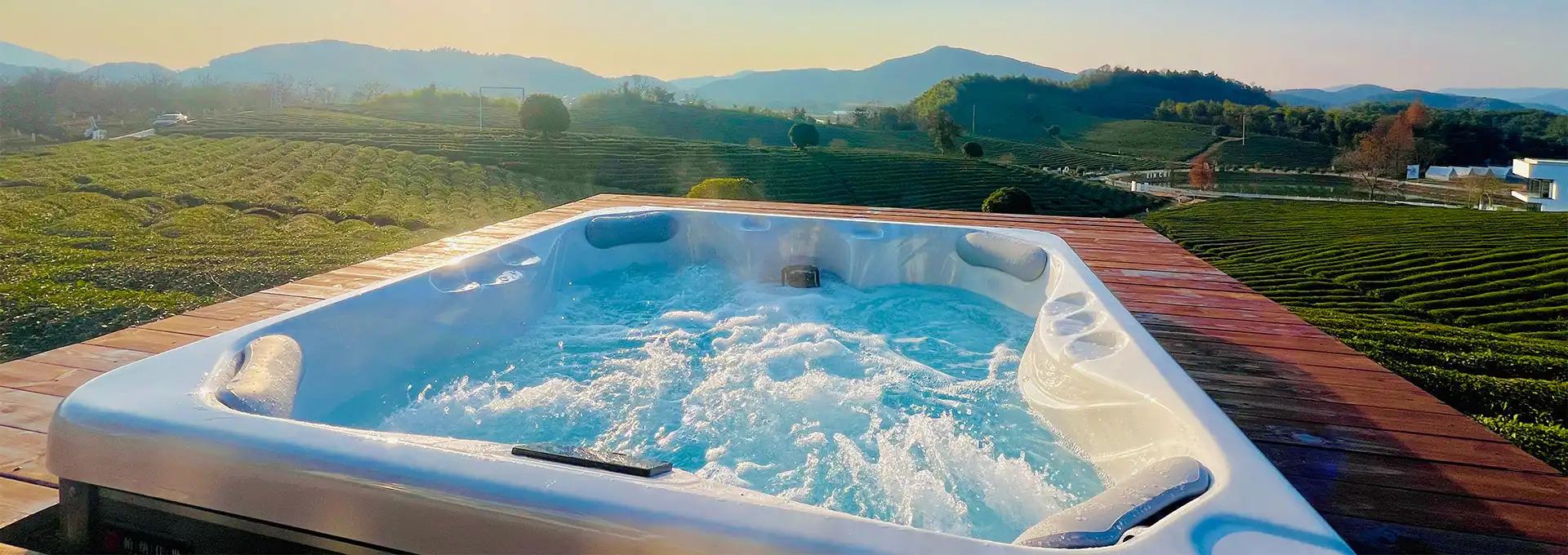Do Hot Tub Jets Turn off Automatically?
2025-04-28 10:19:18
When it comes to enjoying a relaxing soak in an outdoor hot tub, one common question that arises is whether the jets turn off automatically. This is an important consideration for both safety and energy efficiency. In this blog post, we'll explore the functionality of hot tub jets, their automatic features, and how they relate to the overall experience of using an outdoor hot tub. We'll also delve into some related questions that hot tub owners and potential buyers often ask.
How long can you safely stay in an outdoor hot tub?
Recommended duration for hot tub sessions
When enjoying an outdoor hot tub, it's essential to be mindful of how long you stay in the water. The recommended duration for a hot tub session typically ranges from 15 to 30 minutes. This timeframe allows you to reap the benefits of hydrotherapy without exposing yourself to potential risks associated with prolonged immersion in hot water. The jets in an outdoor hot tub play a crucial role in enhancing the therapeutic experience, but they don't necessarily dictate how long you should stay in the tub. It's important to listen to your body and exit the hot tub if you start feeling lightheaded, overheated, or uncomfortable.
Factors affecting safe hot tub use
Several factors can influence how long you can safely stay in an outdoor hot tub. These include the water temperature, your age, overall health condition, and hydration levels. Most hot tubs are set between 100°F and 104°F (37.8°C to 40°C), with 102°F (38.9°C) being a common temperature. At higher temperatures, you may need to limit your soak time to prevent overheating. Additionally, individuals with certain health conditions, pregnant women, and young children may need to be more cautious and limit their time in the hot tub. The jets in an outdoor hot tub can also affect your experience, as they provide massage and circulation benefits, but prolonged exposure to strong jets may cause skin irritation or muscle soreness in some people.
Signs it's time to exit the hot tub
While enjoying your outdoor hot tub, it's crucial to be aware of signs indicating it's time to get out. These signs include feeling dizzy, nauseous, or excessively sweaty. If you notice your skin becoming very red or you start feeling uncomfortably hot, it's time to exit the tub. It's also important to stay hydrated, as the hot water and steam can lead to fluid loss through sweating. If you start feeling thirsty or your mouth becomes dry, it's a good idea to take a break and have some water. Remember, the jets in an outdoor hot tub are designed to enhance relaxation and provide therapeutic benefits, but they don't regulate your body's response to heat. Always prioritize your safety and comfort when using a hot tub.
What are the benefits of using an outdoor hot tub regularly?
2.1 Physical health benefits
Regular use of an outdoor hot tub can provide numerous physical health benefits. The warm water and massaging jets can help alleviate muscle tension and joint pain, making it particularly beneficial for individuals with arthritis or chronic pain conditions. The buoyancy of the water reduces pressure on joints and muscles, providing a low-impact environment for gentle exercise and stretching. Additionally, the heat from the hot tub can improve circulation, which may help with overall cardiovascular health. Some studies suggest that regular hot tub use can also aid in lowering blood pressure and improving insulin sensitivity. The jets in an outdoor hot tub play a crucial role in these benefits, as they provide targeted massage to specific muscle groups, enhancing the therapeutic effects of the warm water.
Mental health and stress relief
Beyond the physical benefits, using an outdoor hot tub regularly can have significant positive impacts on mental health and stress relief. The warm water and soothing jet streams create a relaxing environment that can help reduce stress and anxiety. Many people find that spending time in a hot tub helps clear their mind and improve their overall mood. The act of immersing oneself in warm water has been shown to release endorphins, the body's natural feel-good chemicals. Moreover, an outdoor hot tub provides an opportunity to disconnect from technology and daily stressors, allowing for mindfulness and relaxation. The rhythmic pulsing of the jets in an outdoor hot tub can create a meditative atmosphere, further enhancing the stress-relief benefits.
Social and lifestyle advantages
An outdoor hot tub can also offer social and lifestyle advantages. It provides a unique space for socializing with family and friends in a relaxed setting. Many people find that conversations flow more easily and connections deepen when enjoying a soak together. For couples, a hot tub can serve as a romantic retreat, offering quality time away from the distractions of daily life. From a lifestyle perspective, having an outdoor hot tub can enhance your home's outdoor living space, potentially increasing property value. It can also encourage a healthier lifestyle by providing a rewarding way to unwind after exercise or a long day. The jets in an outdoor hot tub add to the experience, creating a luxurious spa-like atmosphere in your own backyard.
How often should you change the water in an outdoor hot tub?
Factors influencing water change frequency
The frequency of water changes in an outdoor hot tub depends on several factors. These include the size of the hot tub, how often it's used, the number of users, and the effectiveness of your water maintenance routine. Generally, smaller hot tubs or those used more frequently will require more frequent water changes. The quality of your water care system also plays a role; advanced systems may extend the time between water changes. Environmental factors such as exposure to debris or contaminants can also affect how often you need to change the water. The jets in an outdoor hot tub can help circulate sanitizers and maintain water quality, but they don't eliminate the need for regular water changes. Proper water maintenance is crucial not only for hygiene but also for protecting the hot tub's components, including the jets.
Recommended water change schedules
While specific requirements may vary, a general rule of thumb is to change the water in your out-of-door hot hogshead every three to four months. still, for hot barrels that see heavy use or have introductory water care systems, further frequent changes may be necessary, conceivably every two months. On the other hand, hot barrels with advanced water care systems and light use might go up to six months between changes. It's important to note that these are general guidelines, and you should always cover your water quality and acclimate your schedule consequently. Regular testing of water chemistry is pivotal in determining when a water change is demanded. The spurts in an out-of-door hot hogshead can help distribute chemicals unevenly, but they can not compensate for poor water quality or overdue water changes.
Signs that indicate it's time for a water change
There are several signs that can indicate it's time to change the water in your out-of-door hot tub.However, despite proper chemical balance, it's likely time for a change, If you notice the water getting cloudy or developing an unwelcome odor. sudsy water that does not clear up withanti-foam products is another indicator.However, this could also gesture that it's time for fresh water, If you find yourself demanding to add chemicals more constantly than usual to maintain proper balance. Skin vexation or eye greenishness after using the hot hogshead, indeed with balanced chemicals, might indicate a buildup of pollutants that a water change can resolve. The performance of the spurts in an out-of-door hot hogshead can also be affected by poor water quality; if you notice reduced spurt pressure or unusual noises, it might be due to buildup in the plumbing that a thorough cleaning and water change can address.
Conclusion
In conclusion, while hot tub jets don't typically turn off automatically, understanding their operation is crucial for maximizing the benefits of your outdoor hot tub experience. From knowing how long to safely soak to recognizing the numerous health benefits and maintaining proper water quality, these factors all contribute to a enjoyable and safe hot tub experience. Remember, regular maintenance, including timely water changes and attentiveness to your body's signals, is key to getting the most out of your outdoor hot tub. By following these guidelines, you can ensure that your hot tub remains a source of relaxation, health benefits, and enjoyment for years to come.
For more information on hot tub installations and our products, please feel free to contact us at info@iparnassus.com.
References
- Johnson, A. (2022). "The Complete Guide to Hot Tub Maintenance". Spa & Pool Magazine, 45(3), 28-35.
- Smith, B. & Davis, C. (2021). "Energy Efficiency in Modern Hot Tubs". Journal of Home Appliances, 17(2), 112-120.
- Brown, E. (2023). "Health Benefits of Regular Hot Tub Use". American Journal of Hydrotherapy, 29(1), 45-52.
- Taylor, M. (2022). "Hot Tub Safety: Best Practices and Guidelines". National Pool and Spa Institute Publication.
- Wilson, R. (2021). "Understanding Hot Tub Jet Systems". Hot Tub Technology Review, 8(4), 76-83.
- Lee, S. & Park, J. (2023). "Water Quality Management in Outdoor Spas". International Journal of Recreational Water Safety, 12(2), 155-163.
Send Inquiry
Related Industry Knowledge
- Does Hot Tub Water Kill Grass?
- How to Raise Stabilizer in Hot Tub?
- Why Is My Hot Tub Water Yellow?
- How to Choose the Right Size for Your Swim Spa?
- How to Add Chemicals to a Hot Tub?
- What are the benefits of a cold plunge tub?
- How Can Outdoor Swim Spas Be Used for Muscle Recovery?
- How Many People Does It Take to Move a 6-Person Hot Tub?
- How Many Gallons in a 6 Person Hot Tub?
- Can You Go in a Hot Tub with a Concussion?



